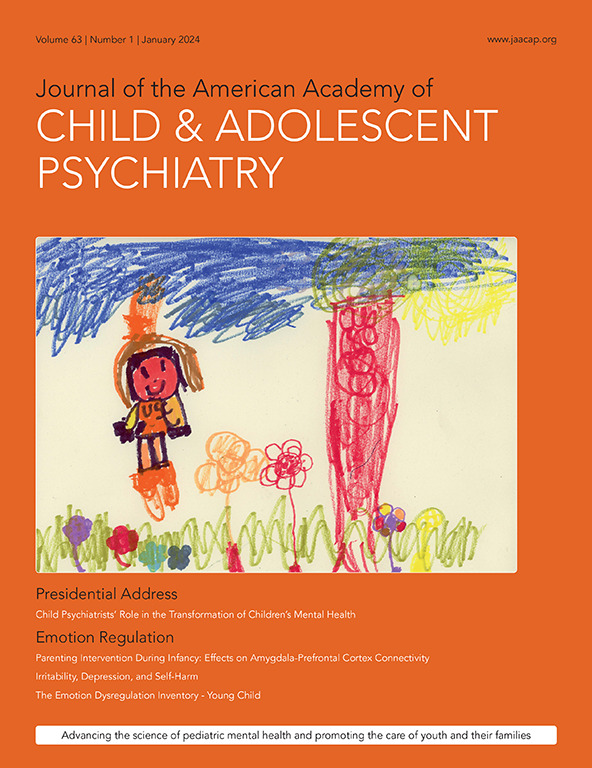产前逆境和新生儿大脑连通性与2岁时新出现的执行功能有关。
IF 9.5
1区 医学
Q1 PEDIATRICS
Journal of the American Academy of Child and Adolescent Psychiatry
Pub Date : 2025-05-04
DOI:10.1016/j.jaac.2025.04.016
引用次数: 0
摘要
目的探讨早期生活逆境对高阶脑网络结构和功能的影响。产前逆境暴露与新生儿白质(WM)微观结构和静息状态功能连接(rs-fc)在新兴EF问题中的潜在影响程度尚不清楚。方法本前瞻性研究包括164名婴儿(45%为女婴,85%为足月婴儿),他们在产前被招募并接受新生儿弥散和rs-fc MRI扫描。在产前评估社会劣势和母亲心理社会压力。2岁时,儿童完成明尼苏达执行功能量表。多变量回归、调节和中介分析检验了产前逆境、新生儿WM微观结构和rs-fc以及新出现的EF结果之间的关系。结果产前社会不利因素(PSD)与新生儿EF不良相关,而与母亲社会心理压力无关。经过多次比较校正,胼胝体中较高的平均扩散率(MD)和较低的分数各向异性(FA),以及额枕下束和皮质脊髓束较高的MD和扣侧较低的FA,与较差的新生EF有关。在适度分析中,新生儿WM微观结构与新生EF之间的关联并没有随着PSD的变化而变化。在中介分析中,新生儿WM微观结构并没有减弱PSD和新兴EF之间的关联。Rs-fc结果未通过多重比较校正。结论psd与新生EF预后较差有关。新生儿WM微结构也与新发EF相关,与低或高PSD儿童有相似的关联。产前社会福利计划可能支持新生儿大脑发育和早期神经发育结果。多样性和包容性我们努力确保招募人类参与者时的性别和性别平衡。我们努力确保招募人类参与者的种族、民族和/或其他类型的多样性。我们努力确保研究问卷的编制具有包容性。本文章由计算机程序翻译,如有差异,请以英文原文为准。
Prenatal Adversity and Neonatal Brain Connectivity Relate to Emerging Executive Function at Age 2 Years.
OBJECTIVE
Early life adversity alters the structure and function of higher-order brain networks that subserve executive function (EF). The extent that prenatal exposure to adversity and neonatal white matter (WM) microstructure and resting-state functional connectivity (rs-fc) underlie problems in emerging EF remains unclear.
METHOD
This prospective study includes 164 infants (45% female, 85% term-born) who were recruited prenatally and underwent neonatal diffusion and rs-fc MRI scans. Social Disadvantage and maternal Psychosocial Stress were assessed in the prenatal period. At age 2 years, children completed the Minnesota Executive Function Scale. Multivariable regression, moderation, and mediation analyses examined associations between prenatal adversity, neonatal WM microstructure and rs-fc, and emerging EF outcome.
RESULTS
Prenatal Social Disadvantage (PSD), but not maternal Psychosocial Stress, was associated with poorer emerging EF. After multiple comparison correction, higher mean diffusivity (MD) and lower fractional anisotropy (FA) in the corpus callosum, as well as higher MD in the inferior fronto-occipital fasciculus and corticospinal tract and lower FA in the uncinate, related to poorer emerging EF. In moderation analysis, associations between neonatal WM microstructure and emerging EF did not vary as a function of PSD. In mediation analyses, neonatal WM microstructure did not attenuate the association between PSD and emerging EF. Rs-fc findings did not pass multiple comparison correction.
CONCLUSION
PSD was related to poorer emerging EF outcomes. Neonatal WM microstructure was also related to emerging EF, with similar associations for children with lower or higher PSD. Prenatal social welfare programs may support neonatal brain development and early neurodevelopmental outcomes.
DIVERSITY & INCLUSION
We worked to ensure sex and gender balance in the recruitment of human participants. We worked to ensure race, ethnic, and/or other types of diversity in the recruitment of human participants. We worked to ensure that the study questionnaires were prepared in an inclusive way.
求助全文
通过发布文献求助,成功后即可免费获取论文全文。
去求助
来源期刊
CiteScore
21.00
自引率
1.50%
发文量
1383
审稿时长
53 days
期刊介绍:
The Journal of the American Academy of Child & Adolescent Psychiatry (JAACAP) is dedicated to advancing the field of child and adolescent psychiatry through the publication of original research and papers of theoretical, scientific, and clinical significance. Our primary focus is on the mental health of children, adolescents, and families.
We welcome unpublished manuscripts that explore various perspectives, ranging from genetic, epidemiological, neurobiological, and psychopathological research, to cognitive, behavioral, psychodynamic, and other psychotherapeutic investigations. We also encourage submissions that delve into parent-child, interpersonal, and family research, as well as clinical and empirical studies conducted in inpatient, outpatient, consultation-liaison, and school-based settings.
In addition to publishing research, we aim to promote the well-being of children and families by featuring scholarly papers on topics such as health policy, legislation, advocacy, culture, society, and service provision in relation to mental health.
At JAACAP, we strive to foster collaboration and dialogue among researchers, clinicians, and policy-makers in order to enhance our understanding and approach to child and adolescent mental health.

 求助内容:
求助内容: 应助结果提醒方式:
应助结果提醒方式:


